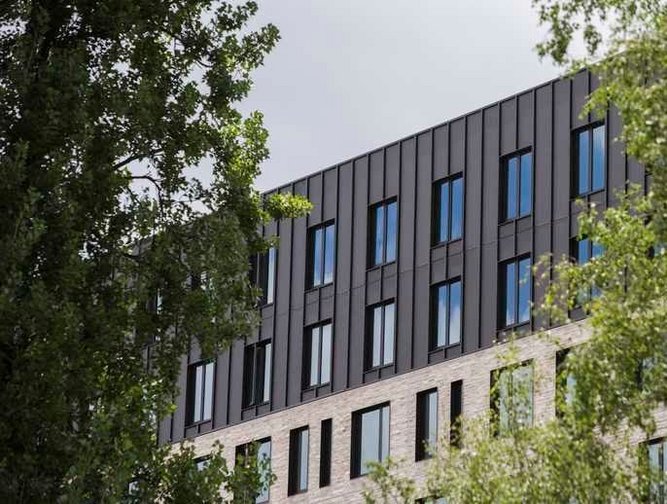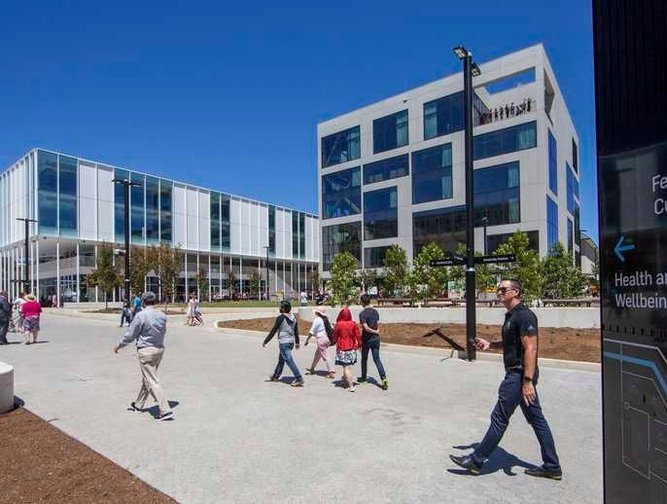The Australian National University’s Acton campus, in the capital city of Canberra, is populated by 24,000 students (6,000 of whom live on site) and over 4,000 staff; the ANU campus is practically a city in its own right. To support ANU’s diverse range of needs – managing physical facilities, IT, corporate governance, finances and more – Chief Operating Officer Chris Grange and his colleagues oversee strategic planning to push forward the performance metrics for all areas of campus life. “My role balances the need to improve the physical development of the campus today while setting up frameworks to maintain that into the future,” explains Grange. “We’ve completed 2,000 new student beds on campus during my time here (since 2013) and we have construction currently underway to deliver another 900.”
The Acton campus is enormous, with over 200 buildings across 145 hectares of land directly adjoining the Canberra CBD, “so actually knowing rather than guessing what's going on around the campus is a really important part of deploying technology”, says Grange. He notes the significance in recent years of focusing on analysis and information management – whether measuring the number of students going into classes, or deploying metering technologies to measure real-time campus usage of electricity, gas and water. “We’ve seen improvements to our analytics platform in terms of understanding student behaviours, perceptions, evaluations and other metrics. One of the key changes for us has been to use data to inform decision making within the university. When you apply that to the physical fabric of the campus, you're really moving into the Internet of Things (IoT), with sensors and smart devices.”
Universities are complex organisations, requiring many individual pieces of technology to support disparate functions. One of the biggest challenges for ANU has been getting those pieces of technology to talk to each other and share information in real time. “We've made a considerable investment in doing that,” asserts Nicki Middleton, Director of Facilities and Services. ANU’s technologically-enabled smart infrastructure network uses an open source communication and control data network within the university to provide demand management capability through a Building Monitoring and Control System (BMCS), interfacing with sensors, building services and appliances. “Ultimately we’re aiming for smart buildings which are sensor filled and capable of, not just following a more efficient program, but actually adapting themselves and moderating their energy consumptions based upon what the sensors tell them about the usage of the building,” says Middleton. “Eventually, this is fertile ground for AI and other concepts to be applied to our building management.”
Allied to that investment, ANU is partnered with IBM for its analytics platform, Cisco for its IT network and Oracle for business solutions and major applications. “IBM’s tools have helped us gain a better understanding of what's happening within the university, and how well we are performing, which is vital. Cisco has aided us with our infrastructure and the further work that will come in that space. Major vendors like Oracle, provide and support many of our most important applications,” confirms Grange.
The university’s approach to Socially Responsible Investment (SRI) and the management of its AUD$1.4bn endowment raised eyebrows back in 2015 when it divested from stocks not in keeping with its social responsibility strategy. “Some elements of the press were very antagonistic,” says Investment Office Director, Mary Fallon, “but the feedback on social media and via email from our students, alumni and the local community was enormously positive.” Fallon has been driving further changes over recent years. “We have reconsidered our management of international equities, revised the funds and investment mandate, and overlaid our SRI policy to our international equities management, applying performance metrics on carbon reduction to how we invest and who we invest in.” ANU has done the same with its domestic equities investment. “We have consistently achieved a reduction in the carbon intensity of our domestic portfolio, that exceeds 25% a year, and we publish an annual report to summarise our progress,” reveals Fallon who believes ANU has been a pioneer in that space.
“We’re now seeing the industry and the investment houses moving to accommodate Environmental, Social and Governance (ESG) and socially responsible investment, it’s a much-improved marketplace,” she notes. “Aberdeen Standard Investment, for example, applies the same ESG standards found in equity portfolios to fixed interest portfolios.” That overlay excludes investment in companies that derive more than 20% of their revenues from coal, gambling, tobacco or pornography.
Grange maintains the development of the Kambri Precinct on campus has been ANU’s biggest improvement in physical facilities in recent years. “It’s a question of how you create a precinct, not just a single building, but an operating precinct which is sustainable from the ground up,” he explains. “We were looking for a method to measure the long-term sustainability of the precinct, and that's where we landed on the ‘one planet’ methodology, using it to measure all of the outputs of this group of seven buildings and outdoor spaces, designing a sustainable outcome.” Alongside the emphasis on metering and monitoring, ANU encourages initiatives like the use of recycled materials and rainwater harvesting. Canberra, as a city, already draws around 90% of its power from green sources, and ANU is one of the two largest consumers of electricity in Canberra.
“The one planet methodology compares you to the sustainability of the planet in its natural state,” explains Grange. “One is neutral so if your score is higher you're depleting the resources of the planet. Less than one, and you're actually making a positive contribution back to the planet. In Kambri, we’ve achieved a score of 0.7. The challenge now is to apply those learnings progressively to the rest of the campus.” Grange muses that in a city already green, the drive must be to become more efficient, reduce the amount of energy consumed and give back to the wider city.
The new Campus master plan’s key goals for ANU’s Acton campus include an energy management strategy with five main objectives to become: a leading energy efficient campus; a carbon positive community with 100% renewable energy; a technologically enabled infrastructure network; capable of independently certified excellence and a platform for infrastructure innovation. The most important innovation for Middleton is the creation of a number of central energy plants. “The traditional concept is to manage energy building by building, but when you're operating a university campus you have enormous opportunities to get economies of scale by servicing multiple buildings or using the outputs from one building to serve another. For example, we have a supercomputer consuming around 25% of all electricity used by the entire campus. The by-product is the generation of an enormous amount of heat. We can capture that heat and reuse it in other buildings, to power hot water systems in student accommodation, for instance. Having already created two of these central energy plants, we're now working on the concept for a third. The aim is to implement this process across the university and harvest the energy efficiencies we get and share the benefits across facilities.”
The ‘energy trilemma’ ANU faces encapsulates the tensions between three distinct aims for future energy systems: maintaining a reliable and secure energy supply; ensuring long term affordability, and drastically reducing GHG emissions associated with energy supply. The ANU will need to roll out large scale, on campus, electricity storage based on batteries, to reduce the significant cost of peak charges, infrastructure upgrades, and reduce network stresses. New campus buildings with PVs will also incorporate battery storage. This can be via connection to a Hub facility, or local storage within the building.
“Demonstrating our green power commitment is important,” reasons Grange. Si Kayser, Associate Director, Capital Financing says “We’re doing that with solar power roof installations but it doesn’t move the dial in terms of our total energy equation. That’s why we are working with a partner on a on the concept of a 5MW solar farm outside Canberra where we can feed that power into the university and beyond from 2021.”
With the energy Grange, Middleton, Fallon, Kayser and their colleagues are bringing to their task, the future looks both smarter and greener for the ANU’s campus and the wider community.









